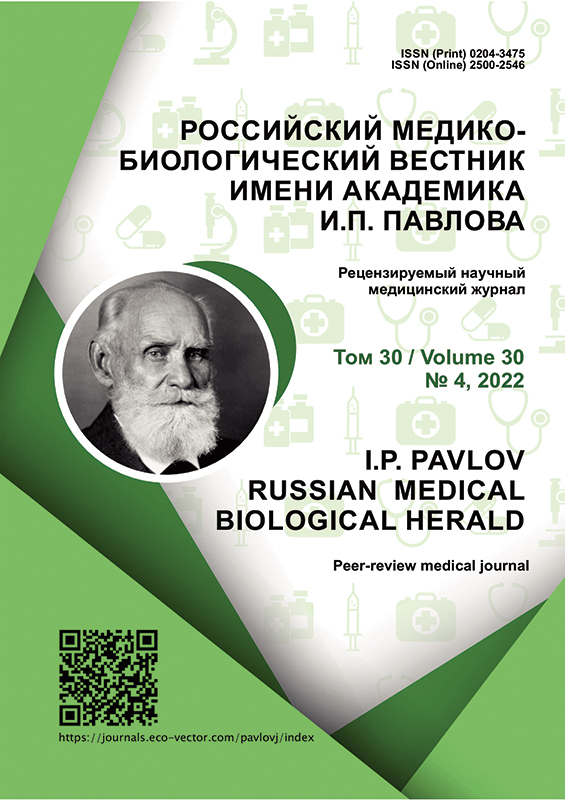Case Report of Development of Atypical Hemolytic-Uremic Syndrome in Pregnancy
- Authors: Smirnova E.A.1, Kurtikova O.V.1
-
Affiliations:
- Ryazan State Medical University
- Issue: Vol 30, No 4 (2022)
- Pages: 555-562
- Section: Clinical reports
- Submitted: 19.04.2022
- Accepted: 29.08.2022
- Published: 28.12.2022
- URL: https://journals.eco-vector.com/pavlovj/article/view/106407
- DOI: https://doi.org/10.17816/PAVLOVJ106407
- ID: 106407
Cite item
Abstract
Atypical hemolytic-uremic syndrome (aHUS) is an ultra-rare (orphan) disease with a progressive course, which is a systemic thrombotic microangiopathy resulting from uncontrolled activation of the alternative complement pathway. There exist the so called ‘obstetric’ thombotic microangiopathies (pre-eclampsia, HELLP syndrome) which are considered as triggers causing development of aHUS in pregnancy in genetically predisposed female patients. Here, the main peculiarity of these pathologies is the improvement of the condition of the puerpera after delivery. In case of ‘non-obstetric’ thombotic microangiopathies, delivery does not lead to regress of symptoms, on the contrary, microangiopathic process progresses with rapid development of multiorgan failure. The development of thrombotic thrombocytopenic purpura and aHUS in pregnancy may induce physiological changes in the organism of a pregnant woman. There occurs a build-up of the activity of von Willebrand factor with a parallel reduction of the activity of ADAMTS 13 enzyme (metalloprotease that cleaves its super-large multimers). This is probably a physiological adaptation of the body to minimize blood loss during childbirth. As a result of the imbalance, the risk of developing thrombotic microangiopathy increases by the end of II — beginning of III trimester. The concept of chronic uncontrolled activation of the alternative complement pathway implies a genetic defect of regulatory proteins with increased formation of C5 convertase, increased release of C5a — a strong chemoattractant, and of membrane–attacking complex C5b–C9, which leads to damage to endothelial cells, exposure of the subendothelial layer and thrombosis. The currently used drug eculizumab is a recombinant humanized monoclonal antibody that binds to the complement C5 protein and suppresses the activation of complement-mediated cell lysis. The article presents a clinical case of the development of aHUS in a patient during pregnancy, the main stages of diagnostic search are considered, routing is determined and the therapy used is justified.
Full Text
About the authors
Elena A. Smirnova
Ryazan State Medical University
Author for correspondence.
Email: smirnova-ea@inbox.ru
ORCID iD: 0000-0003-0334-6237
SPIN-code: 6503-8046
ResearcherId: Y-1235-2018
MD, Dr. Sci. (Med.), Associate Professor
Russian Federation, RyazanOl'ga V. Kurtikova
Ryazan State Medical University
Email: kurtikova.ov@gmail.com
ORCID iD: 0000-0001-8792-8888
SPIN-code: 7837-8237
ResearcherId: AAX-4264-2021
Russian Federation, Ryazan
References
- Kozlovskaya NL. Atypical hemolytic uremic syndrome: current understanding of the pathogenesis, clinic, approaches to diagnosis and treatment. Tromboz, Gemostaz i Reologiya. 2019;(4):13–20. (In Russ). doi: 10.25555/THR.2019.4.0895
- Kozlovskaya NL, Prokopenko EI, Emirova KhM, et al. Klinicheskiye rekomendatsii po diagnostike i lecheniyu atipichnogo gemolitiko-uremi-cheskogo sindroma. Nephrology and Dialysis. 2015;17(3):242–64. (In Russ).
- Gunkova EV, Vyalkova AA, Zorin IV. Hemolytic-uremic syndrome in children, associated with diarrhea (literature review). Nephrology (Saint-Petersburg). 2021;25(3):43–51. (In Russ). doi: 10.36485/1561-6274-2021-25-3-43-51
- Krasnopol'skiĭ VI, Shifman EM, Kulikov AV, et al. Report on Experts Forum «Thrombotic microangiopathies and atypical hemolytic-uremic syndrome in obstetrics. The first step to cross-disciplinary consensus». Russian Bulletin of Obstetrician–Gynecologist. 2017;17(1):118–25. (In Russ). doi: 10.17116/rosakush2017171118-125
- Baiko SV. Epidemiology and pathophysiology of hemolytic uremic syndrome associated with shiga toxin (literature review). Nephrology (Saint-Petersburg). 2021;25(3):36–42. (In Russ). doi: 10.36485/1561-6274-2021-25-3-36-42
- Korotchaeva YuV, Kozlovskaya NL, Bondarenko TV, et al. «Obstetric» atypical hemolytic uremic syndrome: a difficult diagnosis? Arkhiv Akusherstva i Ginekologii imeni V.F. Snegiryova. 2015;2(2):36–41. (In Russ).
- Sánchez–Luceros A, Farías CE, Amaral MM, et al. Von Willebrand factor-cleaving protease (ADAMTS-13) activity in normal non-pregnant women, pregnant and postdelivery women. Thrombosis and Haemostasis. 2004;92:1320–6. doi: 10.1160/TH03-11-0683
- Novikov AV. Atypical hemolytic-uremic syndrome in general and in pregnancy. V.F. Snegirev Archives of Obstetrics and Gynecology. 2018;5(3):132–9. (In Russ). doi: 10.18821/2313-8726-2018-5-3-132-139
- Kalinin RE, Suchkov IA, Egorov AA, et al. Endothelial dysfunction in program hemodialysis-dependent patients. Nauka Molodykh (Eruditio Juvenium). 2019;7(1):79–85. (In Russ). doi: 10.23888/HMJ20197179-85
- Gulov MK, Abdulloev SM, Rofiev HK. Quality of life in patients with chronic kidney disease. I.P. Pavlov Russian Medical Biological Herald. 2018;26(4):493–9. (In Russ). doi: 10.23888/PAVLOVJ2018264493-499
- Kozlovskaya NL, Korotchaeva YuV, Bobrova LA, et al. Obstetric atypical hemolytic uremic syndrome: the first Russian experience of diagnosis and treatment. Nephrology (Saint-Petersburg). 2016;20(2):68–80. (In Russ).
- Kupina AD, Petrov UA, Berezovskaya KE. Features of etiology and pathogenesis of atypical hemolytic-uremic syndrome in obstetrics and gynecology. Health & Education Millennium. 2019;21(5):47–51. (In Russ). doi: 10.26787/nydha-2226-7425-2019-21-5-47-51
- Tsai H–M. A Mechanistic Approach to the Diagnosis and Management of Atypical Hemolytic Uremic Syndrome. Transfusion Medicine Reviews. 2014;28(4):187–97. doi: 10.1016/j.tmrv.2014.08.004
- Lavrishcheva IuV, Jakovenko AA, Kudlay DA. The experience of using the Russian biosimilar of the original drug eculizumab for the treatment of patients with atypical hemolytic-uremic syndrome. Therapeutic Archive. 2020;92(6):76–80. (In Russ). doi: 10.26442/00403660.2020.06.000649
Supplementary files











